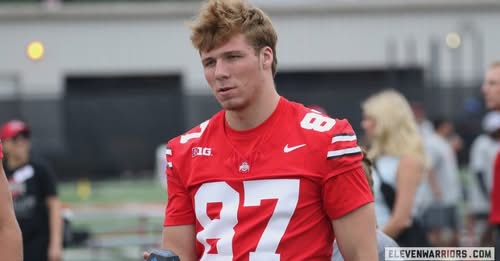Brody Lennon delivered a breakout performance during his junior year of high school, showcasing his versatility on both sides of the ball. As a receiver, he hauled in 32 catches for 750 yards and found the end zone 11 times. Defensively, he was a force to be reckoned with, racking up 95 total tackles, including an impressive 30 tackles for loss.
Brody Lennon’s junior season was more than just a step forward — it was a full-blown breakout. The kind of year that turns heads, sparks conversations among recruiters, and leaves coaches across the region scrambling to figure out how to contain him. A two-way standout with a rare blend of athleticism, physicality, and instinct, Lennon didn’t just participate on both sides of the ball — he dominated.
His offensive numbers speak for themselves. With 32 receptions totaling 750 yards, Lennon averaged nearly 24 yards per catch, a staggering statistic that reflects both his big-play ability and his reliability as a deep threat. Defensive backs couldn’t afford to take a single play off when lined up against him. He ran sharp routes, showed excellent body control when adjusting to the ball midair, and had a knack for finding soft spots in coverage. And when he got his hands on the ball, he made the most of it. Eleven touchdowns in a single season is impressive in any context, but when those scores are paired with limited targets and still come with such high yardage, it speaks to the kind of efficiency and explosiveness that few players can offer.
What made Lennon’s season all the more remarkable was his ability to excel in such a physically demanding role on defense as well. While some players specialize, Lennon thrived in the chaos of the defensive side of the game. His 95 total tackles over the course of the season are a testament not just to his motor, but to his football IQ. He read plays quickly, diagnosed run versus pass in an instant, and flowed to the ball with purpose. More impressively, 30 of those tackles came behind the line of scrimmage. That kind of penetration disrupts offensive rhythm and forces opposing coordinators to adjust their game plan on the fly.
The sheer number of tackles for loss also hints at another side of Lennon’s game: his fearlessness. He wasn’t content to sit back and react. He attacked. Whether firing through gaps to bring down ball carriers or slipping past blockers on blitzes, he was constantly in the backfield, creating havoc and changing the tone of games.
Coaches rave about players who have a “nose for the ball,” and Lennon fits that description perfectly. His pursuit angles were smart, not reckless, and he rarely found himself out of position. That’s not easy to do for someone playing high reps on both sides of the field. Fatigue wears down even the most talented athletes, but Lennon showed remarkable endurance and consistency week after week.
The dual-threat aspect of Lennon’s game makes him especially intriguing as a college prospect. Wide receivers who can deliver explosive plays and score touchdowns are always in demand, but when that same athlete is also capable of anchoring a defense, it raises questions about where he might be best utilized at the next level. Is he a future All-Conference wideout? A lockdown linebacker or hybrid safety? Or does he continue to develop into one of those rare players who can make an impact on both sides in college — or even at the professional level?
Part of what separates Lennon from the pack is his mental toughness. Junior year is often the most critical for high school athletes with college aspirations. It’s the year scouts and recruiters pay closest attention to — the time when potential must begin turning into production. For Lennon, the pressure didn’t seem to affect him. If anything, it brought out the best in him. He played with confidence but never crossed into arrogance. He was physical but disciplined, aggressive but smart.
There’s also the leadership factor. Teammates looked to Lennon not just for his playmaking, but for his presence. He set the tone at practice, pushed others to give their best, and didn’t shy away from the moments that mattered most. In tight games, he made the key catch or came up with the pivotal tackle. In blowouts, he stayed locked in and helped keep the team focused. That kind of consistency and maturity is rare in a high school athlete and speaks volumes about his character.
Beyond the stats, Lennon’s game film reveals the full picture. On offense, his route tree is more advanced than what you’d typically see at the high school level. He sells fakes well, understands leverage against defenders, and displays soft hands with the ability to catch passes in traffic. He’s not just a one-route guy. Whether he’s running fades, slants, digs, or posts, Lennon creates separation and makes himself a reliable target. His yards-after-catch ability is another weapon. Once the ball is in his hands, he turns into a running back — lowering his shoulder to break tackles or using his speed to outrun pursuit angles.
Defensively, his versatility is just as pronounced. While he may line up most often in the box, Lennon shows the ability to drop into coverage and hold his own against tight ends and slot receivers. He understands zone concepts and doesn’t get lost in space. That makes him a three-down player — someone who can stay on the field regardless of the situation. Whether it’s a 3rd-and-short or a 3rd-and-long, Lennon is an asset.
Physically, he’s still growing into his frame, which is perhaps the most exciting part. He already plays with a level of strength and explosiveness that overwhelms most high school competition, but there’s room for further development. As he continues to add muscle and refines his technique, the ceiling only gets higher. College strength and conditioning programs will help sharpen the raw tools he already possesses, and it’s easy to imagine him becoming a dominant force at the next level.
Recruiters watching Lennon are seeing more than just a highlight reel. They’re seeing a complete football player — someone who checks boxes across the board: production, toughness, leadership, athleticism, and upside. Whether a program is looking for an impact receiver, a high-motor linebacker, or a dynamic athlete who can be molded to fit their scheme, Lennon presents as an ideal candidate.
As his senior season approaches, the spotlight will only intensify. Expectations are high, and attention from colleges is certain to increase. But if Lennon’s junior campaign is any indication, he’s built to handle it. He’ll enter the new year not just with momentum, but with a reputation — one that will make opponents game-plan around him and scouts zero in on him. He’ll likely see double coverage on offense and more traps and misdirections on defense. But knowing how he responded to pressure as a junior, there’s every reason to believe he’ll rise to the occasion again.
There’s also the intangible quality that’s hard to measure but easy to recognize when you see it: the will to compete. Lennon plays with a fire that’s impossible to fake. He doesn’t take plays off. He doesn’t shy away from contact. He embraces the grind of the season, the film study, the weight room, the recovery. He’s the type of athlete who loves the process as much as the product — and that bodes well for his future.
In the broader context of high school football, Brody Lennon’s junior year will stand as a defining chapter in his young career. He didn’t just put up big numbers — he made a statement. He established himself as a top-tier talent with the potential to impact the game at every level. And perhaps more importantly, he set the standard for what’s expected of himself going forward. The journey from high school standout to collegiate success is never guaranteed, but with his skill set, mindset, and track record, Brody Lennon is well on his way to making that leap.



